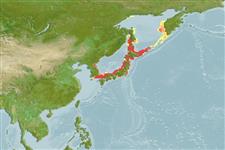>
Salmoniformes (Salmons) >
Salmonidae (Salmonids) > Salmoninae
Etymology: Oncorhynchus: Greek, onyx, -ychos = nail + Greek, rhyngchos = snout (Ref. 45335).
Environment: milieu / climate zone / depth range / distribution range
Οικολογία
Θαλασσινό(ά); Γλυκού νερού; Υφάλμυρο βενθοπελαγικό; ανάδρομο (Ref. 51243); εύρος βάθους 0 - 200 m (Ref. 50550). Temperate; 65°N - 34°N, 127°E - 158°E
Northwest Pacific: Japan and adjacent waters.
Μέγεθος / Βάρος / Age
Maturity: Lm ? range ? - ? cm
Max length : 79.0 cm TL αρσενικό/απροσδιόριστο; (Ref. 56527); μεγ. δημοσιευμένο βάρος: 10.0 kg (Ref. 9988)
The fluviatile form generally inhabits headwaters and often maintains a territory; it feeds mainly on insects but also on small crustaceans and fishes. The sea-run form goes downstream forming schools, and after a short stay in the brackish zone enters the sea where it feeds on small fishes and pelagic crustaceans. Oviparous (Ref. 205). Eggs are buried in unguarded nests (Ref. 205). Marketed fresh and frozen; eaten broiled and baked (Ref. 9988).
Distinct pairing (Ref. 205). Reproductive strategy: synchronous ovarian organization, determinate fecundity (Ref. 51846).
Masuda, H., K. Amaoka, C. Araga, T. Uyeno and T. Yoshino, 1984. The fishes of the Japanese Archipelago. Vol. 1. Tokai University Press, Tokyo, Japan. 437 p. (text). (Ref. 559)
IUCN Red List Status (Ref. 130435)
Endangered (A1ac; B2abcde+3abd); Date assessed: 01 August 1996
Threat to humans
Harmless
Human uses
αλιεία: Εμπορικό(ά); Υδατοκαλλιέργειες: Εμπορικό(ά); αλιεία αναψυχής: ναί
Περισσότερες πληροφορίες
ΑναφορέςΥδατοκαλλιέργειεςΠροφίλ υδατοκαλλιέργειαςΣτελέχοιΓενετικήElectrophoresesΚληρονομικότηταΑσθένειεςΜεταποίησηNutrientsMass conversion
Εργαλεία
Special reports
Download XML
Διαδικτυακές πηγές
Estimates based on models
Preferred temperature (Ref.
123201): 0.3 - 16.5, mean 3.3 °C (based on 86 cells).
Phylogenetic diversity index (Ref.
82804): PD
50 = 0.5000 [Uniqueness, from 0.5 = low to 2.0 = high].
Bayesian length-weight: a=0.00955 (0.00605 - 0.01506), b=3.03 (2.90 - 3.16), in cm total length, based on LWR estimates for this species & Genus-body shape (Ref.
93245).
Τροφικό Επίπεδο (Ref.
69278): 3.6 ±0.59 se; based on food items.
Ελαστικότητα (Ref.
120179): Μεσαίο(α), ελάχιστος χρόνος για διπλασιασμό πληθυσμού 1,4 - 4,4 έτη (tm=4; tmax=6; Fec=1,000).
Fishing Vulnerability (Ref.
59153): Moderate to high vulnerability (52 of 100).
Climate Vulnerability (Ref.
125649): Moderate to high vulnerability (49 of 100).
Nutrients (Ref.
124155): Calcium = 14.3 [4.9, 37.9] mg/100g; Iron = 0.265 [0.131, 0.597] mg/100g; Protein = 18.2 [17.0, 19.3] %; Omega3 = 1.64 [0.75, 3.60] g/100g; Selenium = 98.8 [29.8, 308.1] μg/100g; VitaminA = 14.2 [4.6, 42.8] μg/100g; Zinc = 0.545 [0.335, 1.074] mg/100g (wet weight);
